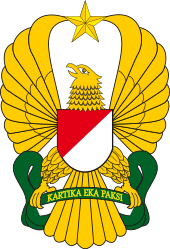Indonesian Military Academy
The Military Academy (Indonesian: Akademi Militer or Akmil) is a military academy of the Indonesian Army, part of the Indonesian National Armed Forces Academy System or the AKABRI. Founded on the early stages of the Indonesian Revolutionary War and located in the city of Magelang in Central Java, its alumni forms a professional officer cadre for the army, with all Indonesian Army Chiefs of Staff since 1988 having graduated from Akmil.[2]
Akademi Militer Tentara Nasional Indonesia | |
 | |
| Motto | धिकाऱ्या महत्व विर्य नगरभक्ति - Adhitakarya Mahatvavirya Nagarabhakti (Sanskrit)[1] |
|---|---|
| Type | Military academy |
| Established | 31 October 1945 |
| Superintendent | MG Arif Rahman, Governor of the Academy |
| Dean | BGEN R. Wisnoe Prasetja Boedi, S.Ip, MM, Vice Governor of the Academy |
| Location | , 7.502708°S 110.213055°E |
| Colors | Blue and White |
| Affiliations | Indonesian National Armed Forces Academies |
| Website | www.akmil.ac.id |
History
In October 1945, several months after the Indonesian declaration of independence, then-Chief of Staff of the Indonesian Armed Forces Oerip Soemohardjo ordered the establishment of a military academy, which was called the Militaire Academie and was based in Yogyakarta. On the aftermath of a ceasefire with the Dutch armed forces in 1949, interest in the school dropped with only 9 cadets in Class 3 (1949 intake) compared to 200 in Class 2 (1946 intake),[3]:9–10 and the academy was closed in 1950 with remaining students sent to the Dutch Koninklijke Militaire Academie. In the following years, several army officer schools would pop out in Indonesia.[4]
Partly in effort to transform a regional, guerilla force into a professional, national military, the then Chief of Staff of the Army Abdul Haris Nasution established the National Military Academy (Akademi Militer Nasional), which was officially opened on 11 November 1957 and included Mount Tidar in its premises within Magelang giving the academy its nickname of Lembah Tidar (Tidar Valley), modeled on the United States Military Academy.[5] The first cadets to graduate from this new institution in 1960 was recognized as Class 4 and numbered 59 graduating officers. Soon in 1961, the Indonesian Army Military Technical Academy (ATEKAD) based in Bandung was merged with the school and the cadets transferred to Magelang. Later, it was integrated with the Indonesian Naval Academy (Akademi Angkatan Laut), Air Force Academy (Akademi Angkatan Udara) and the Police Academy (Akademi Angkatan Kepolisian) to form the Indonesia National Armed Forces Academy System (AKABRI) in 1965.[4][6]:38
In 1984, reorganization of the armed forces resulted in the academy renamed to its current form, the Military Academy Magelang (Akademi Militer). The Taruna Nusantara high school, established in 1990 by Akmil alumni Try Sutrisno and located just outside the military academy, was created in order to attract young talent to the academy.[7]:54–55 After the reformation and the removal of dwifungsi, the Police Academy was separated from AKABRI leaving Akmil, AAU, and AAL within the structure.[4]
Recent developments
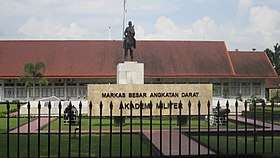
Starting in 2011, graduates of the academy were awarded a bachelor's degree (in applied defence sciences, Indonesian: Sarjana Sains Terapan Pertahanan) along with other academies in AKABRI.[8] In 2017, the academy had its first female graduates,[9] among a graduating class of 225 cadets.[10]
Academics

Just like so many military academies in the world, the Indonesian Military Academy Magelang is a medium-sized, highly residential baccalaureate college, with a full-time, four-year undergraduate program that emphasizes instruction in the arts, sciences, and professions with a graduate program, preparing men and women to take on the challenge of being officers of the Indonesian Army. The academy is accredited by the Ministry of Education. Cadets who passed the initial selection process will first attend a 1-year basic program in the premises of the Academy with students from the Air Force, Naval and Police academies, and remain there for the remainder of their studies.
Undergraduate program - academic
The academic program consists of a structured core of subjects depending on the cadet's chosen specialty as a future Army officer, balanced between the arts and sciences. Regardless of major, all cadets graduate with a Bachelor of Applied Defense Science degree.
Undergraduate program - military
As all cadets are commissioned as second lieutenants upon graduation, military and leadership education is nested with academic instruction. Military training and discipline fall under the purview of the Office of the Vice Governor and Commandant of Cadets. Entering freshmen, or 4th class cadets, which come from high school graduates of private and public educational institutions, are referred to as New Cadets, and enter the academy on Reception Day (in September) to start off their military service training as future officers and are recognized as full cadets in a ceremony in January the following year alongside cadets from the other service branches and the National Police, where they receive ceremonial daggers and the senior ranked cadets receive their Cadet Corporal sleeve insignia. The 2nd, 3rd and 4th years of study, aside from the usual academic work, also involve specialty training in the combat arms of the Army in their respective combat training schools stationed nationwide. Selected cadets are also selected for foreign exchange studies in the military academies of Singapore, Thailand, the Philippines, the United States, Malaysia, Singapore and Vietnam, among others.
The Academy also has links with military academies in the Asia-Pacific, the United States Military Academy and the Royal Military College of Canada and thus also has a sizable number of foreign exchange cadets who graduate as Second Lieutenants and with a bachelor's degree and thus return to their countries of origin to serve in their ground forces. Given its Dutch traditions as a former colonial territory the academy is also linked with the Koninklijke Militaire Academie in Breda, The Netherlands.[11]
At the end of their final year, the cadets, after finishing their final exams, march out of the Academy fields in July in their graduation parade, and graduate within days in a national ceremony in Jakarta's Independence Palace, wherein the cadet valedictorian receives his/her Second Lieutenant shoulder board from the President of Indonesia, while the salutatorian recites with his/her fellow graduates the commissioned officers' oath of office.[12]
Cadet life
Cadets are not referred to as freshmen, sophomores, juniors, or seniors. Instead they are officially called fourth class, third class, second class, and first class cadets, or generally as Taruna-Taruni Akmil (Cadets of the Academy) as a whole. As the national military college its cadets, male and female, come from all over Indonesia as well as foreign exchange cadets from many countries of the world who study in its halls.
Corps of Drums Canka Lokananta and Regimental Band of the Military Academy
The Corps of Drums "Canka Lokananta" (Drum Band Genderang Seruling "Canka Lokananta") and the Regimental Band of the Military Academy Magelang (Satuan Musik Upacara Akademi Militer) are the official military band and corps of drums, respectively, of the Indonesian Military Academy, having started in 1959 after the reopening of the Military Academy in its current Magelang campus, thus they are the senior premier musical representatives of the Indonesian Army, modeled on similar formations mounted by the Royal Netherlands East Indies Army Military School in Bandung, Gombong and Purworejo. While the Band (composed of 36 musicians) is manned by active duty military personnel assigned to the academy, the Corps of Drums of around 182 drummers, fifers and trumpeters is manned by the officer cadets that are part of the Corps of Cadets.[13] Both organizations fulfill all of the official musical requirements of the Academy, including military and patriotic ceremonies, public concerts, sporting events and radio and television broadcasts, as well as social activities for the Corps of Cadets, alumni of the academy and the entire community of Magelang, while appearing in all national events involving the Indonesian National Armed Forces as the seniormost field units of its military academies. While the Band is led by a Director of Music and a Bandmaster together with the Band Sergeant Major, the Corps of Drums is led by a Senior Drum Major and 4 Assistant Drum Majors (Penatarama), which lead the Corps on parades and ceremonies with their long maces to direct the drummers, fifes and trumpeters.
Former President Susilo Bambang Yudhoyono, himself a former graduate of the Military Academy, was part of the drumline battery of the Corps of Drums, which changes every year from the incoming and outgoing musicians selected from amongst the ranks of the Corps.[14] He was a tenor drummer during his stinct as part of this formation, and during a June 2014 visit, he was joined by fellow alumni musicians of the Corps of Drums of the 1973 graduating class.
Notable alumni
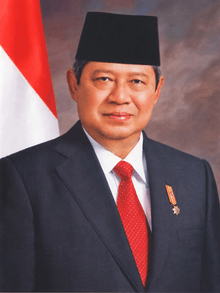
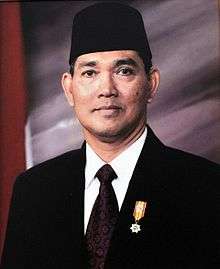
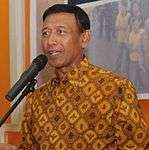
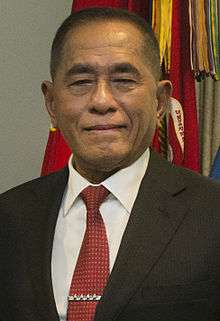 Ryamizard Ryacudu, 24th Minister of Defense and former Army Chief of Staff
Ryamizard Ryacudu, 24th Minister of Defense and former Army Chief of Staff Gatot Nurmantyo, former commander of the Indonesian National Armed Forces
Gatot Nurmantyo, former commander of the Indonesian National Armed Forces Prabowo Subianto, chairman of Gerindra and 25th Minister of Defense
Prabowo Subianto, chairman of Gerindra and 25th Minister of Defense
References
- "Lambang". Akademi Militer Indonesia (in Indonesian). Retrieved 3 September 2017.
- "Alumni". Akademi Militer. Retrieved 3 September 2017.
- Akademi Militer Nasional Indonesia, tahun 1962 (in Indonesian). Akademi Militer Nasional. 1962. Retrieved 3 September 2017.
- "Sejarah". Akademi Militer. Retrieved 3 September 2017.
- Bachtiar, Imelda (10 November 2016). "59 Tahun Akademi Militer: Menjadi Indonesia dari Lembah Tidar" (in Indonesian). Kompas. Retrieved 3 September 2017.
- Kammen, Douglas; Chandra, Siddharth (2010). A tour of duty : changing patterns of military politics in Indonesia in the 1990s (1st Equinox ed.). Jakarta, Kuala Lumpur: Equinox Publishing. ISBN 9786028397131.
- Haseman, Angel Rabasa, John (2002). The Military and Democracy in Indonesia Challenges, Politics, and Power. Santa Monica: RAND. ISBN 9780833034021.
- "Hore! Lulusan Akademi TNI Dapat Gelar Sarjana". detiknews (in Indonesian). DetikNews. 11 July 2011. Retrieved 3 September 2017.
- Sipasulta, Nathazha; Timur, Fitri Bintang (5 August 2017). "Welcome first female military academy graduates". The Jakarta Post. Retrieved 3 September 2017.
- Safutra, Ilham (26 July 2017). "Mantan Office Boy Raih Adhi Makayasa AAL" (in Indonesian). JawaPos. Retrieved 3 September 2017.
- "UPAYA TNI DALAM MENINGKATKAN WAWASAN INTERNATIONAL TARUNA AKADEMI MILITER MAGELANG" (in Indonesian). Universitas Muhammadiyah Yogyakarta. Retrieved 5 September 2017.
- Suhada, Amirullah (25 July 2017). "Presiden Jokowi Hari Ini Lantik 729 Taruna dan Taruni TNI-Polri" (in Indonesian). Tempo. Retrieved 5 September 2017.
- https://magelangimages.wordpress.com/2014/04/11/canka-lokananta-the-melodious-sound-from-tidar-valley/
- https://news.detik.com/berita/d-2618995/ini-gaya-sby-tampil-bersama-taruna-drum-band-akmil-magelang
